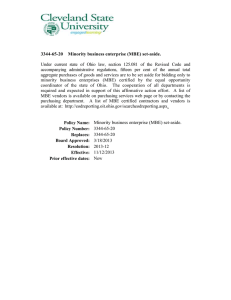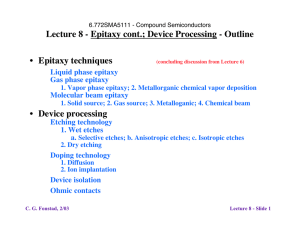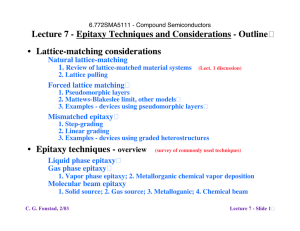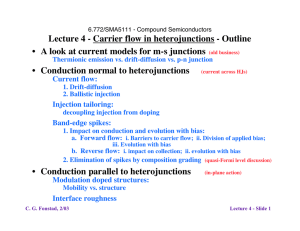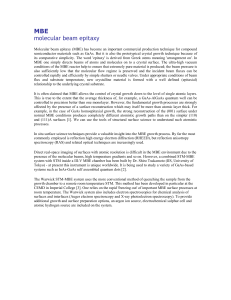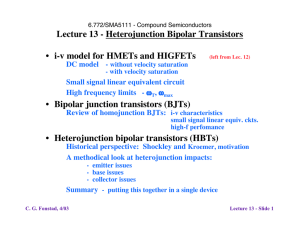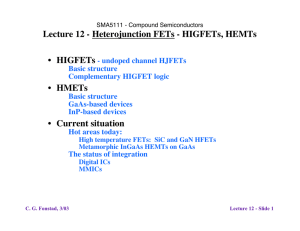� Control of r. f. nitrogen plasma source in solid source MBE
advertisement
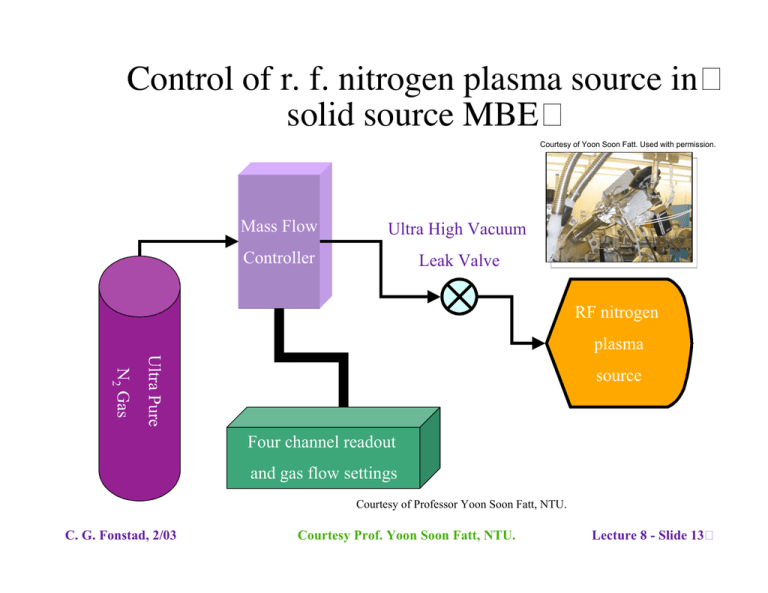
Control of r. f. nitrogen plasma source in� solid source MBE� Courtesy of Yoon Soon Fatt. Used with permission. Mass Flow Ultra High Vacuum Controller Leak Valve RF nitrogen plasma Ultra Pure N2 Gas source Four channel readout and gas flow settings Courtesy of Professor Yoon Soon Fatt, NTU. C. G. Fonstad, 2/03 Courtesy Prof. Yoon Soon Fatt, NTU. Lecture 8 - Slide 13� In-situ monitoring of monolayer growth� Courtesy of Professor Yoon Soon Fatt, NTU. Courtesy of Professor Yoon Soon Fatt, NTU. Reflection high energy electron diffraction (RHEED) pattern of a GaAs surface observed during epitaxial growth at As overpressure condition. C. G. Fonstad, 2/03 Courtesy of Yoon Soon Fatt, NTU. Courtesy Prof. Yoon Soon Fatt, NTU. Lecture 8 - Slide 14 Insert 1 - MBE surface reconstruction and RHEED� MBE surface action 1. Growth mechanism 2. Surface reconstruction 3. RHEED system overview 4. Origins of RHEED oscillations 5. Control panel w. RHEED display 6. RHEED oscillation plot C. G. Fonstad, 2/03 Lecture 8 - Slide 15 � Variations on the MBE theme� Solid Source MBE - all elemental sources � Advantages: no toxic gases Disadvantages: large heat load; phosphides require cracker or sublimation source Gas Source MBE - column V hydrides; elemental group III's� Advantages: easy access to phosphides; no As or P cells to recharge � Disadvantages: large heat load; toxic gases; additional pump load � Metalorganic MBE - column III metalorganics; elemental V's � Advantages: reduced heat load Disadvantages: phosphides difficult; MO purity an issue; carbon contamination a concern; additional pumping load; little advantage over SSMBE; more complex chemistry Chemical Beam Epitaxy - MOCVC in high vacuum, beam limit � Advantages: small heat load; phosphides easy; selective area growth possible Disadvantages: additional pumping load; carbon contamination possible; MO purity an issue; toxic gases C. G. Fonstad, 2/03 Lecture 8 - Slide 16 � Critiquing the Epitaxy Techniques� Liquid Phase Epitaxy� Advantages: inexpensive; equilibrium growth; excellent layer quality; low toxicity Disadvantages: complicated to do multiple layers; poor thickness control; materials and combinations limited; uniformity an issue; hard to scale up Vapor Phase Epitaxy [chloride and hydride transport] � Advantages: high purity; low toxicity Disadvantages: complex, messy; memory effects; poor thickness control; unifomity an issue Metalorganic Chemical Vapor Deposition [esp. low P] � Advantages: excellent control; fast response; versatile; many� materials; selective area growth possible� Disadvantages: toxic gases; uniformity and issue� Molecular beam epitaxy� Advantages: beam technique; insitu monitoring; monolayer control Disadvantages: slow; expensive; maintenance of UHV required C. G. Fonstad, 2/03 Lecture 8 - Slide 17 � Epitaxial growth techniques� n� n� Molecular Beam Epitaxy (MBE) – Ultra high vacuum condition n� Solid source MBE – Elemental� sources of In, Ga, Al, As and P � n� Gas source MBE – Combination of � elemental source (for group III) and � gas source (for group V) Riber Production MBE6000 (Courtesy of MBE Technology (S) Pte Ltd) Metalorganic Chemical Vapor Deposition (MOCVD) – Low vacuum condition � n� Gas sources such as TMG, TMI, � TMA, AsH3 and PH3 are used.� MOCVD C. G. Fonstad, 2/03� Courtesy Prof. Yoon Soon Fatt, NTU. MOCVD Lecture 8 - Slide 18 � Insert 2 - Comparison of MOCVD and MBE results� Comparison of MOCVD and MBE 1. RTD performance 2. 2DEG mobility 3. PL spectra of AlGaAs C. G. Fonstad, 2/03 Lecture 8 - Slide 19 � Growing Quantum Wires and Dots - beyond quantum wells � Grow and pattern� •�Growing quantum wells and patterning them into wires� and/or dots is generally not the method used. The patterns� needed are too small and the dimensions are hard to control.� Direct growth� •�The more common approach is to grow on a specially� prepared surface so that the resulting heterostructure� contains quantum wires or dots� •�Quantum wires: –�1. Growth on stepped surfaces –�2. Growth on grooved surfaces •�Quantum dots: – Growth of thin, highly mismatched layers C. G. Fonstad, 2/03� Lecture 8 - Slide 20 � Growing Quantum Wires -� MOCVD on V-grooves (Image deleted) (Image deleted) See X-L Wang et al, Appl. Phys. Lett. 71 (1997) 2130-2. See M. Walther et al, Appl. Phys. Lett. 60 (1992) 521-3. TEM Growth objective (Image deleted) (Image deleted) See M. Walther et al, Appl. Phys. Lett. 60 (1992) 521-3. See X-L Wang et al, Appl. Phys. Lett. 71 (1997) 2130-2. TEM Calculated wavefunctions C. G. Fonstad, 2/03 Lecture 8 - Slide 21 Growing Quantum Dots - dots = boxes � Stranski Krastanov strain-driven growth of dots:� Layer sequence � (Images deleted) See M. H. Son et al, Appl. Phys. Lett. 82 (2003) 1230-3. Cross-section TEM of stacked dots (termed self-assembled quantum dots, SAQDs) After somewhat more than a monolayer of InAs has been deposited, dots form. Empirically it is found that 1.8 monolayers per dot layer is an "optimum" amount. The dots in subsequent layers tend to form over the underlying dots, resulting in ordered stacking (self-assembly). C. G. Fonstad, 2/03 Lecture 8 - Slide 22 III-V Processing - General Comments/Overview � General Picture� III-V device processing is in general more complex than silicon processing in that 1. there are no native oxides comparable to SiO2 2. many of the constituent elements in the III-V semiconductors have high vapor pressures and are subject to decomposition unless encapsulated or under pressure On the other hand, with the III-Vs� 1. one has the availability of complex� heterostructures� 2. there are very selective etches available to differentiate between heterostructure components C. G. Fonstad, 2/03 Lecture 8 - Slide 23 � III-V Processing - General Comments, cont.� Doping� diffusion: �open tube (a la Si) not practical sealed ampoule - to provide As or P overpres. from spin-on glasses and doped metals ion implantation: standard process RTA activation Device isolation mesa etching proton (H+) bombardment: makes many wider bandgap III-V's like GaAs, InP high resistance Passivation, encapsulation� no native oxides; oxidation not viable - sulfidation maybe deposited SiO2 and Si3N4 widely used - Ga diffuses thru SiO2, but not Si3N4 C. G. Fonstad, 2/03� Lecture 8 - Slide 24 III-V Processing - General Comments, cont. � Ohmic contacts deposition and alloy of doped metals - e.g. Au-Zn narrow bandgap ohmic contact layer - e.g. InGaAs heavily doped layer contact layer - Si standard too. Wet etching there are highly selective etches for III-V heterostructures that can be used to advantage in device processing: Etchants that differentiate between AlGaAs and AlAs, or between GaAs and AlGaAs for selected AlGaAs aluminum fraction ranges Similar etchants in the InGaAlAs system Etchants that differentiate between InGaAlAs and InP Dry etching widely employed: see following foils C. G. Fonstad, 2/03 Lecture 8 - Slide 25 � Insert 3 - III-V processing � Etching, doping, and contacting the III-Vs� (22 foils from Prof. Chua Soo Jin, NUS) � Final comments - What's hot in epi today... � AlGaInN on whatever: substrates are the problem Sapphire (Al203), Silicon Carbide (SiC) Gallium Nitride - if available Si - <111> best InGaAs on GaAs and GaInAsN on GaAs: getting longer wavelength, higher mobilities on an inexpensive substrate (rather than on InP) GaAs and InP on Si: dealing with 1. lattice mismatch, � 2. antiphase domains, and 3. thermal expansion coefficients C. G. Fonstad, 2/03 Lecture 8 - Slide 26 �
